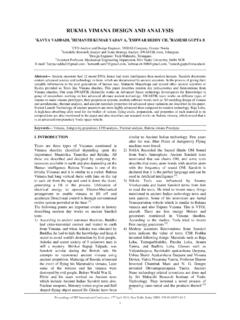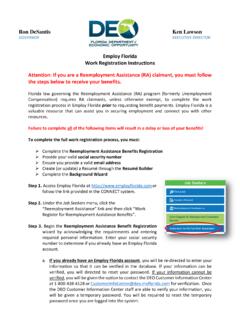Transcription of OVERCURRENT RELAY COORDINATION FOR PHASE AND …
1 Proceedings of 7th IRF International Conference, 27th April-2014, Pune, India, ISBN: 978-93-84209-09-4 57 OVERCURRENT RELAY COORDINATION FOR PHASE AND EARTH FAULTS USING ETAP SHILPI SAINI Electrical and Electronics Department, Amity University (AUUP), Noida, India Abstract- Power system protection and control has always been a subject of concern during emergency conditions in a power system like a zero power condition or blackout. Therefore in order to prevent such conditions, protection system needs to be strong and reliable.
2 Relays form the basis of any power system protection system whose operation settings should be in such a way that it provide correct discrimination and prevent any power blackout. In this paper, COORDINATION of over current relays for a66 KVindustrialsystem is done using ETAP (Electrical Transient Analysis Program) software for PHASE and ground faults. The star view of ETAP software is its unique feature which is helpful in coordinating the OVERCURRENT relays correctly. The load flow results for the system are also shown in the paper.
3 Index Terms- OVERCURRENT RELAY , RELAY COORDINATION , Radial System, ETAP software I. INTRODUCTION OVERCURRENT Relays are the simplest type of protective devices available. It is easy to set the pick up values of individual relays but the problem arises when each RELAY has to be coordinated with every other RELAY in the system. This problem is further aggravated when there are large interconnected systems. The unique feature of ETAP software the star view is very useful in case of large interconnected power systems.
4 Thus, this paper shows the OVERCURRENT RELAY COORDINATION of a given system using ETAP s star view. The important characteristics of an OVERCURRENT RELAY are: selectivity, reliability and discrimination. For any kind of fault be it symmetrical or unsymmetrical, the OVERCURRENT RELAY has to operate efficiently and provide correct discrimination. The OVERCURRENT RELAY settings must be set such that it operates for only the faults nearby it or the primary these relays should operate after a certain time lag and act as back up protection for other relays.
5 II. SYSTEM DESCRIPTION A system is delivering MW to its loads of which MW is fed from the grid and MW is fed from one generator. There are three generators in the plant, of which one is under maintenance, one in cold standby and one is running. The system is shown in All the three generators have same ratings MW, 18% steady state reactance, connected to the KV bus. The two transformers present in the system also have same ratings of 25 MVA, 66 KV, %Z = loads which are connected to the system, mainly consist of motor loads.
6 Here these are assumed to be lumped loads of MVA and MVA capacitors of 4 MVar ratings are present on the two sides of sectionalizing circuit breaker. Firstly load flow analysis is performed on the system to check its load generation balance. III. LOAD FLOW REPORT Results of the load flow are shown in appendix 1. IV. RELAY COORDINATION CONCEPT The basic rules for correct RELAY co-ordination can generally be stated as follows [1]: a. whenever possible, use relays with the same operating characteristic in series with each other OVERCURRENT RELAY COORDINATION for PHASE and Earth faults using ETAP Proceedings of 7th IRF International Conference, 27th April-2014, Pune, India, ISBN: 978-93-84209-09-4 58 b.
7 Make sure that the RELAY farthest from the source has current settings equal to or less than the relays behind it, that is, that the primary current required to operate the RELAY in front is always equal to or less than the primary current required to operate the RELAY behind it. Also following parameters for the various devices connected to the system must be considered [2]: OVERCURRENT RELAY COORDINATION curve for the feeder must lie below the feeder overload and feeder short circuit damage curve on the time current characteristics graph.
8 Also the OVERCURRENT RELAY COORDINATION curve for the feeder must lie above the ampacity curve of the feeder. OVERCURRENT RELAY COORDINATION curve for the transformer must lie below the transformer through fault mechanical and thermal damage curve. Also the OVERCURRENT RELAY COORDINATION curve for the transformer must lie above the ampacity curve and the magnetizing inrush points of the transformer. OVERCURRENT RELAY COORDINATION curve for the generator must lie above the generator full load ampere curve of the generator.
9 Also the OVERCURRENT RELAY COORDINATION curve for the generator must lie below the decrement curve and the overload curve. The flowchart for the RELAY COORDINATION procedure is shown in figure 2 below. Figure 2. RELAY COORDINATION Procedure. V. RELAY COORDINATION SETTINGS The RELAY current setting is given by Plug Setting Multiplier (PSM) and the time settings are given by the Time Dial Settings. The formula for finding the PSM is given by: PSM = (Through Fault Current)/(CT Ratio)*( RELAY current setting) For example the OVERCURRENT RELAY (51 & 51G) settings are shown below for 66KV Incomer RELAY : 66KV Incomer RELAY GROUP -51 RELAY type used = 7SJ80 CT ratio Primary = 800 A Secondary = 1 A Backup Calculation.
10 Ampacity of the cable = 705 A Current seen by the CT = 705/800 = O/C PSM with margin at 110% = Time Setting = Curve type= Inverse GROUP -51G RELAY type used = 7SJ80 CT ratio Primary = 800 A Secondary = 1 A Backup Calculation: Ampacity of the cable = 705 A Current seen by the CT = 705/800 = O/C PSM with margin at 120% = TMS = Curve type = Inverse The RELAY current and time settingsfor all other relays in the system are shown in the table in The earth fault settings for the relays is generally 20 -30% of the rated current of the system.





